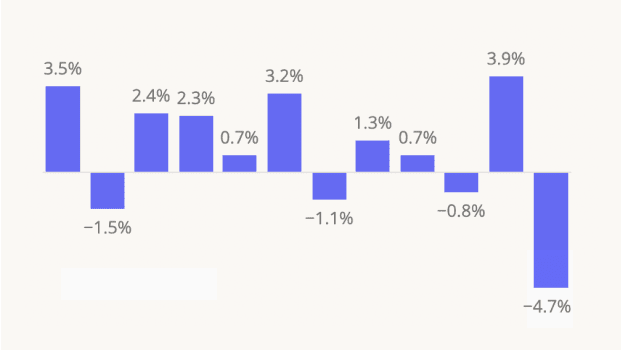
Home-cooked meals may anchor the holidays, yet dining out remains a key part of the seasonal rhythm. Examining how visits trended last year helps illuminate which segments could gain the most traction this December and where holiday dining demand may concentrate.
Fine Dining Leads the Holiday Charge
While the holiday season is a major period for retail, some dining segments also experience a notable lift. Visits to the coffee category outperformed their 2024 weekly average in November, likely boosted by the appeal of leading chains' holiday menu and the popularity of Starbucks' Red Cup Day. The category saw another surge the week before Christmas, as shoppers sought out caffeine to power through last-minute errands.
Full-service restaurants tend to see visitation build towards the end of the holiday season – visits were 7.1% higher than average the week of December 16th, 2024, and remained elevated during the week of Christmas, even as other dining categories experienced slight dips. This likely reflects the shift from workday and errand-driven routines to family gatherings, out-of-town guests, and special-occasion meals. Meanwhile, categories like QSR, fast casual, and coffee tend to soften as commuting, shopping, and other everyday behaviors pause for the holiday.
Meanwhile, fast-casual and quick-service segments trended lower during holidays than they did during the rest of the year – though the week before Christmas bucked the trend, likely lifted by shoppers stopping for quick meals amid last-minute errands.
Upscale Dining Leads Full-Service Growth
Within full-service dining, upscale and fine-dining concepts were the clear standouts of the season. The segment saw steady gains throughout December, culminating in a 33.7% jump the week of December 16th and remaining elevated into Christmas week – a pattern likely supported by companies and large groups booking higher-end restaurants for end-of-year celebrations.
Breakfast-first chains, by contrast, showed softer performance for most of the period and only saw meaningful lifts during family-focused holiday weeks, when out-of-town visitors and holiday traditions drove more morning and brunch outings.
Casual dining and eatertainment concepts also experienced holiday-related bumps, but in distinct ways. Casual dining saw a brief boost the week of November 11th, likely tied to Veterans Day promotions, and then a more meaningful lift the week before Christmas as consumers grabbed convenient meals while running last-minute errands. Eatertainment venues, on the other hand, peaked during Christmas week, benefiting from families seeking activity-based outings once holiday gatherings were underway. While neither category matched the sustained strength of upscale dining, each captured demand consistent with the role they play in the holiday dining cycle.
Lead-up To The Holidays
Looking ahead to this year’s holiday season, the year-over-year dining patterns point to a dining landscape led once again by upscale and fine dining. This segment is the only one showing consistent momentum heading into November, with steady gains that suggest another strong December for premium full-service concepts.
The rest of the full-service category is entering the season on more uneven footing. Breakfast-first chains, eatertainment venues, and casual dining brands are all tracking close to or below last year’s levels, with several weeks of declines and only brief periods of improvement. While the weeks of November 10th and 17th offer early signs of stabilization for some segments, the broader picture remains mixed.
Still, holiday dining behaviors typically shift sharply as Thanksgiving, Christmas travel, and family gatherings come into focus. If past patterns hold, all four segments may see meaningful late-season lifts – but upscale dining is the category best positioned to outperform as the holidays accelerate.
Ready, Set, Dine!
Upscale and fine dining, coffee, and breakfast-first chains demonstrated clear seasonal lifts last year. As December approaches, will these patterns re-emerge, or will consumer caution lead to wider pull-backs among the dining segment?
For the most up-to-date dining data, check out Placer.ai’s free tools.
Placer.ai leverages a panel of tens of millions of devices and utilizes machine learning to make estimations for visits to locations across the US. The data is trusted by thousands of industry leaders who leverage Placer.ai for insights into foot traffic, demographic breakdowns, retail sale predictions, migration trends, site selection, and more.

“Turkey Wednesday” – the day before Thanksgiving – is the Black Friday of the grocery sector. Shoppers flock to supermarkets nationwide to pick up everything from turkey to cranberry sauce. And for grocery retailers, the resulting traffic surge marks one of the most important days of the year.
So with the holiday just under our (admittedly, slightly loosened) belts, we dug into the data to see how this year’s milestone performed. Did economic uncertainty or online alternatives keep shoppers home? Or did the milestone drive results?
Turkey Wednesday Delivers the Big Lift
The data leaves little room for doubt: Turkey Wednesday delivered once again. On November 26th, 2025, visits to grocery stores surged 82.6% above the average day from November 2024 through October 2025. And across the full pre-Thanksgiving week (November 20th–26th), traffic climbed 26.8% above the weekly average.
Turkey Wednesday this year also outperformed 2024: Year over year (YoY), overall grocery visits increased 5.8% on Turkey Wednesday, while the average number of visits per individual location rose 4.8%. And looking at the entire week before Thanksgiving, overall traffic and average visits per location rose 5.1% and 4.1%, respectively.
A Two-Phased Shopping Period
Which grocery segments contributed the most to the pre-holiday traffic surge? Digging into the data for different grocery formats reveals a clear divide between Turkey Wednesday itself and the days leading up to the milestone, with each segment contributing at different moments.
On Turkey Wednesday, traditional supermarkets came out on top. Visits to chains like Kroger, Safeway, and H-E-B climbed 85.6% above their 12-month daily average, a larger jump than in 2024. Value and specialty chains also posted YoY gains that outpaced last year – though their spikes were smaller than those seen at traditional grocers.
But widening the lens to the entire week before Thanksgiving reveals a more nuanced picture. While traditional grocery chains dominated Turkey Wednesday itself, value grocery stores have become increasingly vital destinations during the broader pre-holiday period. Over the full week, value grocery visits rose 27.8% above their weekly baseline, edging out the 26.8% increase for traditional supermarkets.
This early-week advantage for budget chains suggests that many price-sensitive shoppers may be planning ahead, spreading trips across multiple days and hunting for better deals before the last-minute rush.
Value Spikes Early While Traditional Wins on the Big Day
Daily visit patterns further highlight the split between early value planners and day-of shoppers. As the chart below shows, value grocery chains consistently outperformed traditional grocers from Thursday, November 20th through Tuesday, November 24th, as shoppers did the bulk of their shopping. Specialty grocers also kept close pace with traditional supermarkets during this period, occasionally pulling slightly ahead.
Then, on Turkey Wednesday, traditional grocery took the lead with a 104.1% jump over a typical Wednesday – well above the other segments. When shoppers move into last-minute mode, it’s the traditional chains’ broad assortments and familiar layouts that draw them in for those final items.
From Stock-Ups to Top-Offs
But while value grocers benefit most from the early phase of holiday shopping, visit-duration data shows that the two-phase pattern plays out across all segments. Between November 20th and 25th, average dwell times rose across grocery formats, peaking on Monday and Tuesday for traditional chains and over the weekend for value and specialty grocers.
Then, on Turkey Wednesday, dwell times eased back from those peak levels – reflecting a shift toward faster, more targeted trips to grab missing ingredients or finalize meal prep. The shift from longer, more deliberate outings to shorter, last-minute stops underscores the two-step rhythm of Thanksgiving shopping: thoughtful planning early on, followed by efficient wrap-ups as the holiday approaches.
Strong Performance Across the Board
Differences between segments notwithstanding, leading grocery chains across formats saw meaningful YoY traffic gains, both on Turkey Wednesday and during the full pre-holiday week. As shown by the chart below, major chains from Trader Joe’s to Meijer experienced YoY increases in the average number of visits to each location during the pre-Thanksgiving rush, pointing to widespread sector-wide strength during the milestone.
A Sign of Good Things to Come
Grocery’s strong performance on Turkey Wednesday – the first big milestone of the holiday period – offers a welcome sign of shopper resilience in a season defined by concerns over confidence.
And as the festive season continues, grocery chains across formats can use these insights to refine their layouts, promotions, and assortments to capture even more pre-holiday traffic. Traditional grocery chains, for example, may look to strengthen their value-focused offerings to appeal to early planners in the pre-Christmas period, while value grocers might consider strategies to capture more of the last-minute traffic that intensifies as the holiday approaches.
For more data-driven grocery insights check out Placer.ai’s free industry trends tool.
Placer.ai leverages a panel of tens of millions of devices and utilizes machine learning to make estimations for visits to locations across the US. The data is trusted by thousands of industry leaders who leverage Placer.ai for insights into foot traffic, demographic breakdowns, retail sale predictions, migration trends, site selection, and more.

The holiday season is apparel’s time to shine. Steep seasonal markdowns draw budget-conscious consumers eager to save a few bucks on refreshing their wardrobes, while a wide array of gift options entices those hunting for that perfect sweater their sister would never buy for herself.
But to make the most of this opportunity, retailers need to understand their shoppers. Who is driving holiday visit traffic to clothing stores – and what are they after?
Off-Price’s Slow Burn vs. Traditional Apparel’s Milestone Spikes
If last year is any indication, off-price brands will likely see a steady climb in visits from early November onward, fueled by continuous markdowns and the treasure-hunt appeal of new inventory. Traditional apparel retailers, by contrast, are more likely to see sharper, event-driven spikes – especially around key milestones like Black Friday.
Differing Dwell Times
The two apparel categories also differ in how shoppers spend their time once they’re in-store.
Traditional retailers see visit durations rise on Black Friday, as shoppers looking to restock their closets take time to browse and try on clothes. But during key December milestones like Super Saturday and the days leading up to Christmas, dwell times actually dip below average as shoppers focus on quick gift purchases rather than personal shopping.
Off-price retailers, on the other hand, sustain longer dwell times throughout most of the season. This suggests that many off-price shoppers are combining gift buying with taking advantage of seasonal prices to purchase clothing for themselves and their families. Only on Christmas Eve do visit durations to off-price retailers fall below average, as shoppers make their final dash for stocking stuffers.
A Broader Mix of Shoppers
Unsurprisingly, off-price retailers draw less affluent shoppers than traditional apparel chains. But during the holiday shopping season, both segments attract broader audiences than usual. Last December, the captured markets of both types of retailers included higher shares of middle- and lower-income consumers that may not typically splurge on new clothes – though as illustrated by the chart below, the shift was more pronounced for off-price retailers.
The Bottom Line
While off-price retailers have seen stronger foot traffic trends this year, the holidays remain a critical period for both segments. And by understanding shifts in consumer behavior, retailers across apparel categories can better tailor their strategies to capture demand:
- For off-price retailers, maintaining a steady cadence of deals and merchandise drops will help keep traffic strong through December – while selectively leaning into milestone events can complement their steady momentum.
- For traditional apparel chains, balancing key shopping days with smaller activations or targeted mid-season promotions can help sustain engagement between major events. Their shorter visits make convenience especially important – simplifying gift zones and promoting “grab-and-go” gift displays for time-pressed shoppers.
- For both segments, engaging even more effectively with value-conscious shoppers will be key to maximizing performance.
For more data-driven apparel insights check out Placer.ai’s free industry trends tool.
Placer.ai leverages a panel of tens of millions of devices and utilizes machine learning to make estimations for visits to locations across the US. The data is trusted by thousands of industry leaders who leverage Placer.ai for insights into foot traffic, demographic breakdowns, retail sale predictions, migration trends, site selection, and more.

The world of work remains in flux as companies and employees keep redefining the new “normal”. On the one hand, hybrid work has become ubiquitous – and remote-driven concepts like “microshifting” are reshaping how we think about maximizing productivity. At the same time, growing awareness of co-location’s role in sustaining the social infrastructure that fuels innovation and success is prompting more companies to call employees back to the office. In 2025 alone, employers from Toyota to JP Morgan Chase, the Washington Post, Paramount/Skydance, and even the federal government joined the wave with five-day-a-week in-office mandates.
But how are these countervailing currents playing out on the ground? Is office foot traffic reaching a plateau or is the return to office (RTO) still gaining momentum?
Progress Still Underway
In October 2025, visits to Placer.ai’s Nationwide Office Index were 30.8% below October 2019 levels. While this represents a larger year-over-six-year (Yo6Y) visit gap than in September, it still signals meaningful progress: September 2025 included one extra working day compared to 2019, whereas October had one fewer. And when controlling for the number of business days, October actually saw 1.2% more traffic than September.
Year over year (YoY), too, nationwide office visits grew 4.7% in October 2025 (see second graph below) – showing that even amid entrenched hybrid norms and ongoing pushback against in-person requirements, office visit numbers continue to trend steadily upwards.
No Big Regional Surprises
Turning to regional RTO trends, Miami and New York continued to lead the post-pandemic recovery pack. In another sign of San Francisco’s emerging turnaround, the city once again outpaced Chicago for Yo6Y growth and recorded the fastest YoY visit growth of any analyzed city. Southern hubs Dallas and Houston also outperformed the nationwide Yo6Y benchmark of -30.8%, while Houston just slightly lagged at 34.9%.
Quiet Quitting on Fridays (Shhh….)
And in another indication of on-the-ground resistance to five-day mandates, location analytics suggests that employees really are quiet-quitting Fridays – at least when it comes to in-office work. Between January and October 2025, just 12.4% of weekday visits to office buildings took place on Fridays, compared to 24.3% on Tuesdays, 23.7% on Wednesdays, and 21.8% on Thursdays.
The extent of the phenomenon varies by market – employees were most likely to make the end-of-week trek to the office in Miami and Dallas and least likely to do so in Boston and Chicago – though no analyzed city saw a share of Friday visits above 15.0%. And despite New York City’s strong overall RTO, the Big Apple trailed the national baseline in Friday attendance.
The Push and Pull of the Post-Pandemic Workplace
October 2025’s Office Index data shows that the RTO story is still far from settled. Hybrid habits remain deeply ingrained, yet steady progress suggests a gradual rebalancing between flexibility and presence – one that will continue to shape the workplace landscape in the months ahead.
For more data-driven office visit insights, follow Placer.ai/anchor.

Thanksgiving may be this month’s biggest Thursday milestone – but for coffee lovers, Thursdays in November are also about Starbucks’ Red Cup Day, when eager fans line up to snag a limited-edition reusable cup, free with any handcrafted holiday beverage.
How did this year’s Red Cup Day stack up? Did the recent Bearista frenzy steal some of the spotlight, or did the two events build on one another to create an even bigger buzz?
The Other Big Thursday in November
On November 13th, 2025, visits to Starbucks surged 44.5% above the year-to-date daily average, reaching an even higher traffic peak than that seen on the day of the Bearista launch. Though November 6th was reportedly Starbucks’ biggest sales day ever in North America, according to CEO Brian Niccol, Red Cup Day drove even higher U.S. visit volumes, as customers turned out in droves to participate in the holiday tradition.
Niccol also noted that November 13th, 2025 marked the strongest Red Cup Day in company history – a claim supported by the data. Foot traffic during the event surged 8.2% higher than in 2023 and 3.1% higher than in 2024.
These results suggest that far from cannibalizing Red Cup Day, the Bearista Cup’s release just days earlier amplified the excitement, creating a sustained wave of engagement across Starbucks’ holiday calendar.
The strong response to these discretionary, purchase-based promotions also shows that when done right, exclusivity, excitement, and brand magic can still bring in the crowds – even in an economic climate marked by uncertainty and waning consumer confidence.
Standing Room Only
In addition to visit volumes, in-store behavior also shifts on major launch days. Unsurprisingly, longer lines lead to longer dwell times, as customers who might normally be in and out quickly wait patiently for their turn. On both November 6th and November 13th, the share of Starbucks visitors staying between 10 and 30 minutes increased substantially compared to an average Thursday, while the share staying under ten minutes declined.
Interestingly, though, the share of visitors who lingered even longer (30+ minutes) to work, study, or relax dropped slightly on the big days – likely because the festive crowds deterred those looking for a quieter place to settle in.
What’s Next for Starbucks?
With the holiday season just getting underway, Starbucks still has plenty of tricks up its sleeve – including the return of its beloved Eggnog and Chestnut Praline Lattes, along with a new wave of festive merchandise launching on December 2nd. Will the coffee leader be able to sustain its winning streak through the end of the year?
Follow Placer.ai/anchor to find out.
Placer.ai leverages a panel of tens of millions of devices and utilizes machine learning to make estimations for visits to locations across the US. The data is trusted by thousands of industry leaders who leverage Placer.ai for insights into foot traffic, demographic breakdowns, retail sale predictions, migration trends, site selection, and more.

Off-price apparel chains are entering the holidays from a position of strength. In a year defined by elevated prices and economic uncertainty, many consumers are trading down to value-driven retailers, and treasure-hunt favorites like TJX, Burlington, and Ross Dress for Less are reaping the rewards.
YoY Visits Visit Growth Across the Board
Between July and October 2025, TJX’s HomeGoods division (HomeGoods + Homesense) saw year-over-year visit growth ranging from 5.6% to 14.3%, while Marmaxx (T.J. Maxx + Marshalls + Sierra) climbed 6.3% to 10.8%. These strong traffic gains align with TJX’s most recent quarterly report, where comparable sales rose and transaction volumes increased across every division.
Burlington also maintained its upward trajectory following a strong Q2 FY25 earnings beat that included 5% comp sales growth. And Ross, which reported a 2% comp sales increase last quarter, saw visits trend strongly upward through late summer and early fall – a welcome sign following its withdrawal of full-year guidance earlier this year amid tariff uncertainty.
Holiday Peaks Ahead
Visitation trends from last year’s holiday season show just how important this period is for off-price retailers – while Black Friday doesn't tend to bring the massive visit spikes seen at other apparel chains, the holidays are still a significant time for the segment.
In December 2024, visits to Burlington surged 62.5% above the chain’s full-year monthly average, while T.J. Maxx and Marshalls saw increases of 54.0% and 53.4%, respectively. Ross posted a more modest 38.3% increase, but still outperformed the broader non-off-price apparel segment. Meanwhile, HomeGoods and Homesense also exceeded the wider home-furnishings category’s December benchmarks.
This outperformance likely stems in part from off-price retailers’ limited e-commerce presence – with Burlington and Ross operating entirely offline and TJX maintaining only a small digital footprint across select banners. But it also reflects the ongoing strength of a category that gives shoppers a low-cost, high-delight way to browse and indulge during the holiday season.
Deck the Halls With Off-Price Offerings
All signs point to a standout season for off-price giants like TJX, Burlington, and Ross – but just how high can their holiday cheer climb this year?
Follow Placer.ai/anchor to find out.
Placer.ai leverages a panel of tens of millions of devices and utilizes machine learning to make estimations for visits to locations across the US. The data is trusted by thousands of industry leaders who leverage Placer.ai for insights into foot traffic, demographic breakdowns, retail sale predictions, migration trends, site selection, and more.




.svg)





.png)
.png)

.png)
.png)



